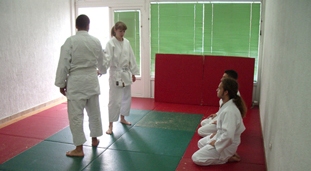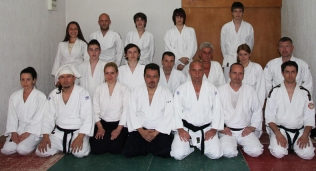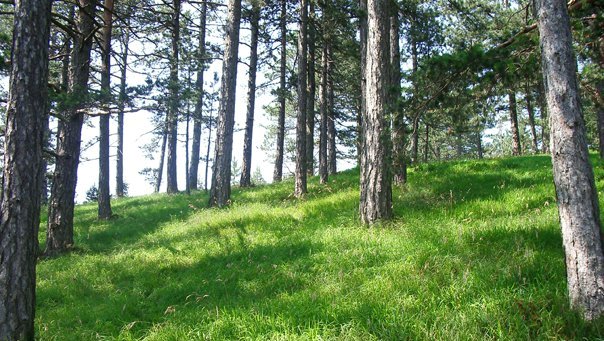|
EXAMINATION PROGRAM - AIKIDO

Examination for Kyu
(student grades) and Dan (master degrees)
Examination is held by an examiner of Aikido
Society recognized by the World Aikido Aikikai
Organization
www.aikikai.or.jp.
Taking the exam for kyu degree requires approval
of instructor and completion of the required
number of trainings and seminars between exams.
For the exam for a day degree is necessary to
meet other requirements (see the program).
After successfully passing kyu grade or dan
degree exam a diploma will be issued, for kyu
grade diploma certified by an Aikikai Aikido
Society and for dan degree diploma certified and
issued by the World Aikikai Aikido Organization
(Hombu Dojo), Tokyo, Japan.
Table of contents:
1. Kyu Grades
2. Dan Degrees
KYU GRADES
| Grade |
Required number of
trainings |
Number of seminars |
| 6th Kyu |
30 |
- |
| 5th Kyu |
40 |
1 |
| 4th Kyu |
50 |
1 |
| 3th Kyu |
60 |
1 |
| 2nd Kyu |
80 |
1 |
| 1st Kyu |
110 |
2 |
6 th
KYU
|
Required condition for
examination: 30 trainings
Aikitaiso
(aikido gymnastics);
Ukemi
(falls);
Taisabaki
(movements);
|
Tachiwaza:
|
Katatetori Aihanmi |
Iriminage |
|
Katatetori Aihanmi |
Kotegaeshi |
|
Katatetori Aihanmi |
Ikkyo
(omote i ura) |
|
Katatetori Aihanmi |
Shihonage
(omote i ura) |
|
Katatetori Aihanmi |
Uchikaitensankyo
(omote
i ura) |
5 th
KYU
Required condition for
examination: 40 trainings and one seminar
after previous examination
Taisabaki (movements); Shikko (movements on the knees)
Tachiwaza:
|
Shomenuchi |
Ikkyo (omote i
ura) |
|
Shomenuchi |
Nikyo (omote i
ura) |
|
Shomenuchi |
Kotegaeshi
|
|
Katatetori |
Tenchinage
|
|
Katatetori
|
Shihonage
(omote i ura) |
|
Katatetori |
Ikkyo (omote i
ura) |
|
Katatetori
|
Udekimenage
(omote
i ura) |
|
Katatori |
Ikkyo (omote i
ura) |
Suwariwaza:
|
Katatetori Aihanmi |
Ikkyo (omote i
ura) |
|
Katatetori Aihanmi |
Iriminage |
|
Ryotetori |
Kokyu Ho
|
4 th
KYU
Required condition
for examination: 50 trainings and one
seminar after previous examination
Tachiwaza:
|
Katatetori
|
Nikyo
(omote i ura) |
|
Ryotetori |
Iriminage
|
| Ryotetori |
Shihonage
(omote i ura) |
| Ryotetori |
Tenchinage
|
|
Ryotetori |
Udekimenage
|
| Ryotetori |
Ikkyo
(omote i ura) |
|
Katateryotetori |
Kokyunage
|
| Shomenuchi |
Sankyo
(omote i ura) |
| Shomenuchi |
Uchikaitensankyo
(omote i ura) |
|
Yokomenuchi |
Shihonage
(omote i ura) |
| Yokomenuchi |
Iriminage
|
| Yokomenuchi |
Kotegaeshi
|
| Yokomenuchi |
Udekimenage
(omote i ura) |
|
Chudantsuki |
Iriminage
|
| Chudantsuki |
Kotegaeshi
|
|
Chudantsuki |
Udekimenage
|
Suwariwaza:
| Shomenuchi |
Ikkyo
(omote i ura) |
|
Shomenuchi |
Iriminage
|
|
Katatori |
Nikyo
(omote i ura) |
3 th KYU
Required
condition for
examination: 60
trainings and one
seminar after previous
examination
Tachiwaza:
|
Katatetori |
Uchikaitennage
|
|
Katatetori |
Sankyo (omote i ura) |
|
Katatetori |
Yonkyo (omote i ura) |
|
Katateryotetori |
Ikkyo (omote i ura) |
|
Katateryotetori |
Nikyo (omote i ura) |
|
Katateryotetori |
Kotegaeshi
|
|
Ryotetori |
Kotegaeshi
|
|
Ryotetori |
Kokyunage |
|
Shomenuchi |
Yonkyo (omote i ura) |
|
Shomenuchi |
Gokyo (omote i ura) |
|
Yokomenuchi |
Ikkyo (omote i ura) |
|
Yokomenuchi |
Uchikaitensankyo (omote i
ura) |
|
Yokomenuchi |
Tenchinage
|
|
Chudantsuki |
Sankyo
(omote i ura)
|
|
Chudantsuki |
Hijikimeosae |
|
Chudantsuki |
Sotokaitennage
|
Ushirowaza:
|
Ryotetori |
Ikkyo (omote i ura) |
|
Ryotetori |
Nikyo (omote i ura) |
|
Ryotetori |
Sankyo (omote i ura) |
|
Ryotetori |
Hijikimeosae
(omote i ura) |
|
Ryotetori |
Kotegaeshi
|
|
Ryotetori |
Shihonage
(omote i ura) |
|
Ryotetori |
Iriminage
|
Suwariwaza:
|
Shomenuchi |
Kotegaeshi
|
|
Shomenuchi |
Sankyo
(omote i ura)
|
|
Katatori |
Sankyo
(omote i ura)
|
2 nd KYU
Required condition for
examination: 80
trainings and one
seminar after previous
examination
Tachiwaza:
|
Shomenuchi |
Jiyuwaza |
|
Yokomenuchi |
Nikyo (omote i ura) |
|
Yokomenuchi |
Sankyo (omote i ura) |
|
Yokomenuchi |
Yonkyo (omote i ura) |
|
Yokomenuchi |
Gokyo |
|
Katateryotetori |
Iriminage |
|
Katatori
Menuchi |
Ikkyo (omote i ura) |
|
Katatori
Menuchi |
Shihonage
|
|
Katatori
Menuchi |
Kotegaeshi |
|
Katatori
Menuchi |
Iriminage
|
|
Katatori
Menuchi |
Koshinage |
|
Munetori |
Ikkyo (omote i ura) |
|
Munetori |
Sankyo (omote i ura) |
|
Munetori |
Shihonage
|
|
Jodantsuki |
Nikyo
(omote i ura)
|
|
Jodantsuki |
Sankyo (omote i ura) |
Ushirowaza:
|
Ryokatatori |
Ikkyo (omote i ura) |
|
Ryokatatori |
Nikyo (omote i ura) |
|
Ryokatatori |
Sankyo (omote i ura) |
|
Ryokatatori |
Iriminage |
|
Ryokatatori |
Kotegaeshi |
|
Ryohijitori |
Kotegaeshi |
|
Ryohijitori |
Iriminage |
|
Katatetori
Kubishime |
Ikkyo (omote i ura) |
Suwariwaza:
|
Shomenuchi |
Yonkyo (omote i ura) |
|
Shomenuchi |
Sotokaitennage |
|
Ryokatatori |
Ikkyo (omote i ura) |
|
Chudantsuki |
Kotegaeshi |
|
Jodantsuki |
Ikkyo (omote i ura) |
1 st KYU
Required condition for
examination: 110
trainings and two
seminars after
previous examination
Basics of stick (jo)
and sword (bokken)
Tachiwaza:
|
Shomenuchi |
Shihonage
(omote i ura) |
|
Shomenuchi |
Tenchinage
|
|
Shomenuchi |
Udekimenage
(omote
i ura) |
|
Munetori
Menuchi |
Ikkyo (omote i ura) |
|
Munetori
Menuchi |
Nikyo (omote i ura) |
|
Munetori
Menuchi |
Sankyo (omote i ura) |
|
Munetori
Menuchi |
Koshinage |
|
Jodantsuki |
Yonkyo (omote i ura) |
|
Jodantsuki |
Iriminage |
|
Jodantsuki |
Shihonage (omote i ura) |
|
Jodantsuki |
Sotokaitennage
|
|
Jodantsuki |
Ushirokiriotoshi
|
|
Jodantsuki |
Koshinage |
|
Katateryotetory |
Iriminage |
|
Katateryotetory
|
Jujigarami
|
|
Ryokatatori
|
Kokyonage
(tri ukea)
|
|
Yokomenuchi |
Jiyuwaza
(tri ukea) |
|
Chudantsuki |
Jiyuwaza (tri ukea) |
Ushirowaza:
|
Ryotetori |
Yonkyo
(omote i ura) |
|
Ryotetori |
Kokyunage
|
|
Ryotetori |
Koshinage
|
|
Katatetori
Kubishime |
Sankyo
|
|
Katatetori
Kubishime |
Hijikimeosae
|
|
Eritori |
Ikkyo
(omote i ura) |
|
Eritori |
Sankyo
(omote i ura) |
|
Eritori |
Koshinage
|
Suwariwaza:
|
Shomenuchi |
Jiyuwaza
|
|
Ryokatatori |
Sankyo
(omote i ura) |
|
Ryokatatori |
Yonkyo
(omote i ura) |
|
Katatori
Menuchi |
Iriminage
|
|
Katatori
Menuchi |
Kotegaeshi
|
|
Katatori
Menuchi |
Kokyunage
|
Hanmihantachiwaza:
|
Katatetori |
Ikkyo (omote i ura) |
|
Katatetori |
Shihonage (omote i ura) |
|
Katatetori
|
Uchikaitennage
|
|
Ryotetori |
Shihonage (omote i ura) |
DAN
DEGREES
SHODAN (1 st
DAN)
Required condition for
examination: 110
trainings and two
seminars after
previous examination,
candidate must be at
least 15 years old
Basic techniques:
|
Tachiwaza |
|
Suwariwaza |
|
Ushirowaza |
|
Hanmihantachiwaza |
Variations of the
basic techniques:
NIDAN (2 nd
DAN)
Required condition for
examination: 2 years
after previous
examination, regular
training, a short
essay (written in a
period no longer than
6 months before the
exam)
Basic techniques:
|
Tachiwaza |
|
Suwariwaza |
|
Ushirowaza |
|
Hanmihantachiwaza |
Variations of the
basic techniques:
SANDAN
(3 th
DAN)
Required
condition for
examination: 3 years
after previous
examination, regular
training, a
short
essay (written in a
period no longer than
6 months before the
exam)
Basic techniques:
|
Tachiwaza |
|
Suwariwaza |
|
Ushirowaza |
|
Hanmihantachiwaza |
Variations of the
basic techniques:
YONDAN
(4 th
DAN)
Required
condition for
examination: 4 years
after previous
examination, regular
training, candidate
must be at least 25
years old, a
longer
essay (written in a
period no longer than
6 months before the
exam)
Basic techniques:
|
Tachiwaza |
|
Suwariwaza |
|
Ushirowaza |
|
Hanmihantachiwaza |
Variations of the
basic techniques:
|
Jiyuwaza (to all
attacks) |
GODAN - JUDAN
(5th
- 10th DAN)
| GODAN
(5th DAN)
|
ROKUDAN
(6th DAN)
|
SHICHIDAN
(7th DAN) |
| HACHIDAN
(8th
DAN)
|
KUDAN
(9th
DAN)
|
JUDAN
(10th
DAN)
|
|
Recommendation of Society
|
> Hombu Dojo
|
>
Promotion
|
*Aikido Organizations
recognized by the
World Aikikai Aikido
Foundation (Hombu
Dojo)
www.aikikai.or.jp.
|









